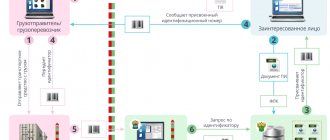Since the industrial revolutions, a situation has developed in the world where some countries have become leaders in certain sectors of production and the economy, while other countries are forced to depend on them. For example, Germany, China, the USA, Great Britain, Israel, etc. have acquired vast experience in the manufacture of complex industrial equipment. In the Russian Federation, this equipment is quite in demand and is used in various fields of industry: chemical, medical, heavy, light, etc.
Domestic entrepreneurs who want to engage in production using complex imported equipment often ask questions: what preliminary documentation needs to be collected, what classification nomenclature codes will be correct, how customs registration will take place at the border, what expenses await them and what the amount that the state will have to pay . organs.
Importing a production line is one of the most difficult tasks: it consists of a huge number of different components and is imported in disassembled condition. Most often, such cargo is registered under one code, but quite often customs does not want to accept the preliminary code that the broker declares, and the inspector indicates the need to change it at his own discretion.
From this we can conclude that the main task of customs is to replenish the state budget by collecting large payments from entrepreneurs who want to import complex goods. That is why customs officers often require the use of codes that will have a duty rate higher than that previously indicated by the declarant. It is worth saying that sometimes such actions of customs representatives will be illegal and subject to challenge in court.
In some cases, it is difficult to determine the required HS code; everything will depend on the properties and functions of the object. In addition, there are a large number of classification interpretations and practices for customs officers to identify codes for such cargo. Differences in encoding will also mean differences in the cost of government payments and duties.
To ensure that the issue of selecting the necessary codes does not become an obstacle to business and does not raise questions during customs clearance of cargo, it is recommended to use the preliminary classification decision of the Federal Customs Service (this is a verdict on the transported object, which is issued by the Federal Customs Service or regional customs departments, if the goods fall under their authority).
The time frame for obtaining a preliminary decision may be 90 calendar days from the moment the application for the decision was submitted and registered. But in some cases the wait can be either shorter or longer, so it is advisable to be patient and it is important to be prepared that changes to classification documents may be required.
The main advantage of a preliminary decision is the ability to apply it within three years from the date of receipt for the import of products that fall under this preliminary decision. In addition, the confirmed code can no longer be challenged by the customs service.
An entrepreneur is recommended to contact specialists in the form of legal consultants and customs representatives who provide preliminary classification consultation services and assistance in obtaining a FCS decision, since preparing the necessary classification documentation and obtaining a preliminary decision will require enough effort, practical skills and theoretical knowledge.
The essence of the FCS classification decision
A domestic organization that decides to import complex equipment must take care of obtaining a preliminary decision, since it is this decision that will allow the import of all components of this cargo under a single classification code of the Commodity Nomenclature of Foreign Economic Activity. However, it is possible to obtain this decision only for some positions from the classification nomenclature of the Eurasian Economic Union.
More specifically, preliminary decisions can only be obtained for goods classified according to the Commodity Nomenclature of Foreign Economic Activity as follows:
- By groups 84–86, 88–90.
- By product positions: 7308, 730900, 8701, 8702, 870410, 8705, 8709, 9301, 940600.
Obtaining a classification decision from the Federal Customs Service gives the importer the following advantages:
- You can move items in different orders during transportation.
- Since the classification code of the Commodity Nomenclature of Foreign Economic Activity will be the same, it is possible to apply a single rate to all objects from the list (sometimes imports with a zero rate are possible).
- For all products as a whole, and not separately for each component link, it is possible to obtain a single permitting act (declaration of conformity or certificate of conformity) if it is necessary.
Let’s figure out what preparatory steps need to be taken to simplify obtaining a preliminary decision and minimize costs.
Professional assistance in obtaining class solutions
The success of the scrupulous and labor-intensive work on preparing class solutions is guaranteed by the qualifications of GPL Cargo employees:
- deep knowledge of Russian customs legislation;
- many years of professional experience;
- awareness of technical expertise
- the ability to adequately reflect the technical features of the goods declared for inclusion in the shipment for transportation;
- the ability to competently argue for the correctness of the class solution in a format appropriate for the Federal Customs Service.
How to obtain classification decisions from customs authorities
Finding the correct code for the object being transported is a rather difficult, but doable task. As mentioned above, an organization involved in the import of complex equipment can take care of obtaining a preliminary decision in advance.
To obtain a customs classification decision, the importer most often needs to provide the following information:
- Constituent documents of the organization requesting the decision.
- Application for provision of a preliminary decision (it is submitted by the customs representative to the Federal Customs Service).
- A complete and detailed list of all equipment components.
- An expanded drawing of a production line or a general technological diagram.
- Description of the operation of the imported equipment in assembled form (it is necessary that the principle of operation of all elements and their connection with each other, as well as the process of obtaining the final product, are clear).
- Foreign trade agreement with the exporter with all specifications (additions).
To complete all the work to obtain a preliminary decision, it will take quite a lot of time (2.5–3 months minimum). This process can be divided into several main stages:
- Preliminary stage. The applicant will need approximately 2-3 weeks to prepare the necessary classification documents and register them. In some cases, the period may increase if it is necessary to obtain additional information from the manufacturer of the product.
- Waiting stage. The customs authority is legally given 20 calendar days to request additional information if it is required to accept the class. solutions.
- The final stage. After the application has been registered, the FCS takes about 60–70 calendar days to issue the required decision.
In case when registering a class. decisions, errors, inaccuracies have been made, or the terms of the foreign trade transaction have changed, it is possible to make the necessary changes to the preliminary decision. To do this, you need to submit a special application to the customs authorities. Civil services have no more than 30 calendar days to adopt and make changes on this issue.
Note that in some cases getting a class. decisions may be delayed or delayed, since civil servants have the right to refuse to consider documents for registering an appeal. Most often, this situation is possible in the following cases:
- Not all information about the imported equipment was provided in full (for example, components of the object are transported separately, but documentation detailing all the elements was not attached).
- The necessary permits and certificates are missing.
- The data of the provided documents does not correspond with each other (for example, the documentation does not contain a link to the attached diagrams, and the diagrams do not indicate all the elements, which makes it impossible to establish their functional purpose among themselves and the main function of the transported cargo as a whole; a register of all components of the equipment by name or quantity does not coincide with the specification attached to the contract).
- There were inaccuracies and errors in the foreign trade agreement between the two parties.
- The applicant did not certify the submitted documents according to the established format.
- Translation of documentation from the foreign seller was not provided.
- The HS code was selected incorrectly.
- Other technical or clerical errors (excessively small font, illegible diagrams or drawings, poor print quality).
Without a doubt, an entrepreneur wishing to submit an application for a classification conclusion should be as careful as possible in the preliminary preparation and final verification of all necessary papers, as well as when submitting the application to the customs authorities. Unfortunately, even this does not guarantee insurance against refusal or additional questions from customs officers. Therefore, all organizations importing complex equipment are advised to take advantage of the advice and support of professional intermediaries to assist in obtaining classification solutions.
What changed the trend?
The main reason is frequent disputes with local customs authorities, whose employees change product codes. And, of course, they are not beneficial to declarants due to the higher duty rate. If you disagree with their decision, customs officers begin to demand an additional package of permits, justifying each number or comma.
The position of customs officers can be understood, because their work is assessed by the amount of duties received into the budget. However, the point of view of the Federal Customs Service and preliminary qualification decisions of regional customs departments may differ fundamentally from the judgments of customs post employees.
The FCS and RTU (regional customs departments), when considering a request for a CD, rely on general classification rules, explanations to the Commodity Nomenclature of Foreign Economic Activity and international practice related to the classification of a similar group of goods. Of course, department officials pay attention to the text of the application submitted by a participant in foreign economic activity, study the documents attached to it, the accuracy and reliability of the description of goods and other documentation.
Customs officers focus primarily on visual inspection and often start a dispute based on the appearance of the goods, which, from their point of view, may not correspond to the code specified by the declarant.
In addition, the FCS makes preliminary decisions only under Article 16 of Federal Law-289. All other cases were transferred, in accordance with departmental order No. 1907 dated September 24, 2012, to the jurisdiction of the RTU. Including the issuance of preliminary decisions on classification.
How much does it cost to obtain classification decisions? Brief process algorithm
Quite often, those wishing to take advantage of the possibility of a preliminary decision have a question about the cost of this decision. Note that not all customs agents are ready to offer their assistance in this matter, since this is a rather unique service, and therefore the price tag for such a service will be appropriate.
Most often, the price for obtaining a classification decision depends on the following factors:
- The principle and features of the operation of imported equipment (the more complex the documentation for the cargo, the more expensive the preliminary decision will be).
- The number of components that make up an industrial line (the price tag for registering a classification report will be higher if the equipment consists of a large number of parts).
- Correctness and completeness of the data provided.
Now we will give a brief algorithm of how the procedure for obtaining a solution occurs.
- A domestic organization decides to engage in the production of some product, but there is no equipment suitable for this process in Russia. She finds the required machine abroad and establishes contact with its supplier. All details of the transaction are negotiated, after which the importer begins to search for a professional broker to draw up a preliminary decision.
- After a reliable agent has been found, work begins on preparing the classification document (all necessary documents are prepared and checked for filing an application with the Federal Customs Service).
- If the outcome is positive (when a decision is received), the sender prepares the cargo for transportation.
- As soon as the equipment arrives at the customs post, a declaration for it and a preliminary decision are provided. The object is then inspected by inspectors and released. After this, it is delivered to the buyer’s warehouse and is ready for its intended use.
Customs clearance procedure for a single production line
Customs clearance of multi-component equipment occurs in stages.
The components included are distributed into separate batches, loaded into several transport units (trucks or containers), depending on the dimensions of the equipment being moved, and delivered to the checkpoint.
A separate goods declaration is submitted for each consignment. The first declaration is accompanied by a package of all necessary documents and a pre-executed classification decision. Subsequent shipments undergo customs clearance according to the previously provided class decision.
After the release of the last DT, the process of customs clearance of equipment is completely completed with the release for domestic consumption of the entire declared production line.
If you have any questions about the procedure for obtaining a preliminary classification decision or are interested in receiving this service, please contact our specialists. To do this, you can use the form at the bottom of the page, the dialog box in the lower right corner of the screen, call or send your request by email. You can also order a call from our specialists and we will contact you to clarify all the details.
Classification decision using "Welmen"
Based on the above, we can conclude that a preliminary decision is a necessary goal for any company that decides to import expensive equipment, since selecting the correct HS code allows you to avoid disputes at the customs post.
In addition, a classification document must also be drawn up when transporting multi-component cargo, since the solution makes it possible to carry out customs clearance of all elements under one HS code.
The customs and logistics department provides a service for obtaining a classification decision according to the Commodity Nomenclature of Foreign Economic Activity code, having vast experience in this matter. Our partnership provides our clients with the following advantages:
- In order for the customer to make preliminary and necessary classification calculations, the company’s employees will draw up a preliminary commercial proposal.
- All classification documents provided will be studied in detail, and after that we are ready to give the necessary recommendations for changing or correcting them.
- We provide preliminary consultation on the class. decision, and also explain in detail all the details and aspects of the process itself.
- Our specialists conduct competent negotiations with government agencies without the participation of the client.
- In addition to the preliminary decision, we also provide the following services: we carry out product certification, engage in international transportation of goods, and undertake full customs support for a wide variety of cargo.
To make the registration process class. the decision has been facilitated, the entrepreneur is recommended to contact us for preliminary consultation and professional assistance. provides only high-quality services due to its main advantages:
- The best prices. Our company is interested in long-term and mutually beneficial partnerships with our clients, therefore we offer the best prices for classification services.
- Customer focus. Professionalism and quality are at the core of our work. We value our partners' time.
- Professionalism. "Welmen" has not only extensive practical experience in registering preliminary decisions, but also in performing any customs and logistics services. Each team member regularly updates his theoretical knowledge in the classification area and beyond.
- Speed. Thanks to the capabilities and abilities of our employees, the customer’s equipment is delivered to the storage location as quickly as possible.
In order to receive more detailed advice on the issue of preliminary decisions or classification documents from our specialists, call +7 or send a request by general mail.
Obtaining a HS code
Applying a profitable product classification is a difficult but feasible task. The importer can obtain a preliminary CD in advance from the customs authority, which the customs post must follow in the process of processing the delivery. It is issued by regional departments: YuTU, SZTU, TsTU, etc. There are classification decisions applied to complex equipment that can be transported across the border in the following types:
- disassembled;
- unassembled;
- unfinished;
- incomplete.
The adoption of such classification decisions falls within the area of responsibility of the Federal Customs Service. They are somewhat more complicated than the preliminary ones, as they require an extended package of documents.
As a rule, a preliminary class decision is issued within 45 days. However, the regulated period is 3 months. It is valid for 3 years and is not subject to challenge by customs officers. To obtain a preliminary classification decision, you need to pay a state fee. services.
Unfortunately, optimizing customs duties legally is associated with bureaucratic difficulties. To obtain the desired code from the Federal Customs Service or the State Technical University, you need to justify the classification.
Preparing a package of documents in order to easily obtain a preliminary classification decision is a labor-intensive and painstaking process, but the end result is worth the effort.
A preliminary classification decision, which sets a single code for the entire cargo, is an ideal option in case of importing a significant volume of goods. The procedure for obtaining a preliminary CD is regulated by Order of the Federal Customs Service of the Russian Federation No. 1907, issued by the regional department of the customs service.







